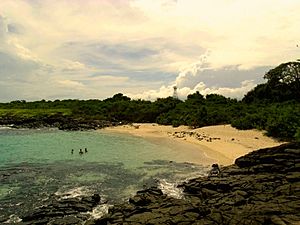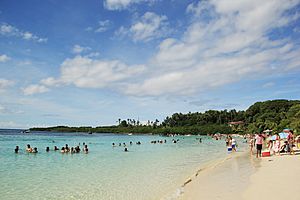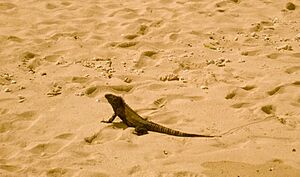Isla Iguana Wildlife Refuge facts for kids
 |
|
| Isla Iguana Lighthouse in 2013 | |
| Location | Isla Iguana Los Santos Province Panama |
|---|---|
| Coordinates | 7°37′42.6″N 79°59′52.6″W / 7.628500°N 79.997944°W |
| Foundation | concrete base |
| Construction | metal skeletal tower |
| Tower shape | square pyramidal skeletal tower with balcony and light |
| Markings / pattern | white tower |
| Height | 12 metres (39 ft) |
| Focal height | 25 metres (82 ft) |
| Range | 10 nautical miles (19 km; 12 mi) |
| Characteristic | Fl W 13s. |
The Isla Iguana Wildlife Refuge is a special protected area for animals and plants. It's about 58 hectares big, which is like 100 football fields! You can find it about 5 kilometers (3 miles) off the coast of Los Santos Province in Panama, near the Azuero Peninsula.
History of Isla Iguana
Long ago, during World War II, the United States Army used Isla Iguana as a place to practice dropping bombs. Don't worry, they cleaned it up! In the 1990s, they carefully removed and exploded some very big bombs (about 2,000 pounds each!) that were stuck in the coral reef around the island.
In the 1960s, a person tried to live on the island and planted plants that weren't from there, like mango and guava trees, corn, and sugar cane. These plants are still on the island today. Later, the government asked the person to leave.
The Isla Iguana Wildlife Refuge became a protected area on June 15, 1981. This means it's now a safe place for all the plants and animals that live there.
Amazing Wildlife
Isla Iguana is home to many cool animals! You can find different kinds of crabs, including hermit crabs, which carry their homes on their backs. There are also black and green iguanas, which are large lizards. Sometimes, you might even spot a boa constrictor, a type of snake.
The island is a very important place for birds, especially the red-throated frigatebirds. These birds have a huge red pouch under their chin that they puff up to attract a mate. Isla Iguana is a key spot where many frigatebirds come to build their nests and raise their babies.
It's also a vital nesting ground for several types of sea turtles. Female sea turtles come to the sandy beaches of Isla Iguana to lay their eggs. This makes the refuge super important for helping these amazing creatures survive.
See also
- In Spanish: Isla Iguana para niños
- List of lighthouses in Panama



